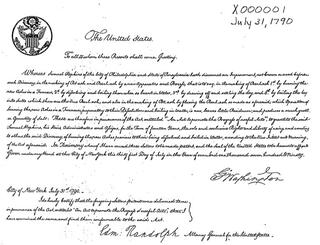 The First US Patent
The First US Patent One of the outcomes of the patents and copyright's clause was the formation of the US Patent and Trademark Office, but in the early years of the republic, obtaining a patent was an informal affair. The first Patent Act povided that a patent would issue if a committee of the Secretary of State, Secretary of War and the Attorney General agreed on the merit of the application.
On July 31, 1790, the first U.S. patent was issued to Samuel Hopkins for an improvement "in the making of Pot ash and Pearl ash by a new Apparatus and Process". The patent was signed by President George Washington, Attorney General Edmund Randolph, and Secretary of State Thomas Jefferson. The other U.S. patents issued that year were for a new candle-making process and Oliver Evans's flour-milling machinery.
Patents were not initially numbers, and when a fire in 1836 destroyed the record of almost all the patents that had been issued up to that point, over 9,000 patents were lost. The Patent Office attempted to replicate the lost records, and the reconstructed archive number the patents included an "X" to indicate that they were not the original. Thus, Hopkins' patent, copies of which were readily available owing to its historic significance, was number X000001. Eli Whitney's Cotton Gin patent was number X000072 and a patent issued to Samuel Colt for an early improve to his multi-chamber revolver, which was among the patents issued just before the fire destroyed the records, was number X09430. One of the lost patents discovered in the Dartmouth College archives in 2004 turned out to be the first known patent for an internal combustion engine. Only about 2800 of the lost patents have been recovered.
 RSS Feed
RSS Feed